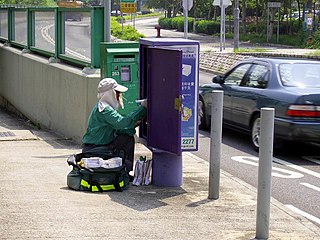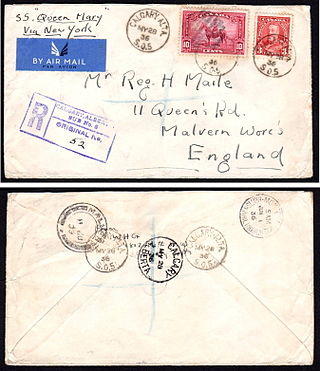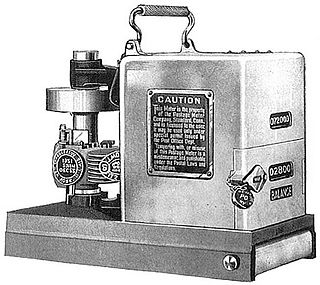
A postmark is a postal marking made on an envelope, parcel, postcard or the like, indicating the place, date and time that the item was delivered into the care of a postal service, or sometimes indicating where and when received or in transit. Modern postmarks are often applied simultaneously with the cancellation or killer that marks postage stamps as having been used. Sometimes a postmark alone is used to cancel stamps, and the two terms are often used interchangeably. Postmarks may be applied by handstamp or machine, using methods such as rollers or inkjets, while digital postmarks are a recent innovation.

The United States Postal Service (USPS), also known as the Post Office, U.S. Mail, or Postal Service, is an independent agency of the executive branch of the United States federal government responsible for providing postal service in the U.S., its insular areas, and its associated states. It is one of the few government agencies explicitly authorized by the Constitution of the United States. As of 2023, the USPS has 525,469 career employees and 114,623 non-career employees.

The mail or post is a system for physically transporting postcards, letters, and parcels. A postal service can be private or public, though many governments place restrictions on private systems. Since the mid-19th century, national postal systems have generally been established as a government monopoly, with a fee on the article prepaid. Proof of payment is usually in the form of an adhesive postage stamp, but a postage meter is also used for bulk mailing.

A ZIP Code is a system of postal codes used by the United States Postal Service (USPS). The term ZIP was chosen to suggest that the mail travels more efficiently and quickly when senders use the code in the postal address.

A postcard or post card is a piece of thick paper or thin cardboard, typically rectangular, intended for writing and mailing without an envelope. Non-rectangular shapes may also be used but are rare.

An envelope is a common packaging item, usually made of thin, flat material. It is designed to contain a flat object, such as a letter or card.

Registered mail is a postal service in many countries which allows the sender proof of mailing via a receipt and, upon request, electronic verification that an article was delivered or that a delivery attempt was made. Depending on the country, additional services may also be available, such as:
POSTNET is a barcode symbology used by the United States Postal Service to assist in directing mail. The ZIP Code or ZIP+4 code is encoded in half- and full-height bars. Most often, the delivery point is added, usually being the last two digits of the address or PO box number.
Franking comprises all devices, markings, or combinations thereof ("franks") applied to mails of any class which qualifies them to be postally serviced. Types of franks include uncanceled and precanceled postage stamps, impressions applied via postage meter, official use "Penalty" franks, Business Reply Mail (BRM), and other permit Imprints (Indicia), manuscript and facsimile "franking privilege" signatures, "soldier's mail" markings, and any other forms authorized by the 192 postal administrations that are members of the Universal Postal Union.

PostBar, also known as CPC 4-State, is the black-ink barcode system used by Canada Post in its automated mail sorting and delivery operations. It is similar to other 4 State barcode systems used by Australia Post and the United Kingdom's Royal Mail, but uses an obscured structure and encoding system unique to Canada Post. This particular bar code system is used on "flats" and parcels.
CPC Binary Barcode is Canada Post's proprietary symbology used in its automated mail sortation operations. This barcode is used on regular-size pieces of mail, especially mail sent using Canada Post's Lettermail service. This barcode is printed on the lower-right-hand corner of each faced envelope, using a unique ultraviolet-fluorescent ink.
Information-Based Indicia (IBI) is a secure postage evidencing standard used by the United States Postal Service (USPS) to indicate electronic postage payment.

A postage meter or franking machine is a mechanical device used to create and apply physical evidence of postage to mailed items. Postage meters are regulated by a country's postal authority. A postage meter imprints an amount of postage, functioning as a postage stamp, a cancellation and a dated postmark all in one. The meter stamp serves as proof of payment and eliminates the need for adhesive stamps.

Freepost is a postal service provided by various postal administrations, whereby a person sends mail without affixing postage, and the recipient pays the postage when collecting the mail. Freepost differs from self-addressed stamped envelopes, courtesy reply mail, and metered reply mail in that the recipient of the freepost pays only for those items that are actually received, rather than for all that are distributed. Freepost of preprinted cards issued by businesses is also different from postal stationery sold by postal administrations.
Courtesy reply mail, or CRM, is a type of mail in which a business sends pre-printed, self-addressed envelopes or postcards to customers, who then affix postage stamps to the envelopes or postcards and mail them back to the business. The business can also disseminate the envelopes or postcards with stamps affixed, similarly to metered reply mail.
Metered reply mail, or MRM, is a type of mail in which a business sends pre-printed, self-addressed envelopes or postcards to customers, with postage prepaid on the envelopes or postcards with a postage meter. It is thus similar to courtesy reply mail with a postage stamp already affixed.
The Postal Alpha Numeric Encoding Technique (PLANET) barcode was used by the United States Postal Service to identify and track pieces of mail during delivery – the Post Office's "CONFIRM" services. It was fully superseded by Intelligent Mail Barcode by January 28, 2013.

The Intelligent Mail Barcode (IMb) is a 65-bar barcode for use on mail in the United States. The term "Intelligent Mail" refers to services offered by the United States Postal Service for domestic mail delivery. The IM barcode is intended to provide greater information and functionality than its predecessors POSTNET and PLANET. An Intelligent Mail barcode has also been referred to as a One Code Solution and a 4-State Customer Barcode, abbreviated 4CB, 4-CB or USPS4CB. The complete specification can be found in USPS Document USPS-B-3200. It effectively incorporates the routing ZIP Code and tracking information included in previously used postal barcode standards.

Mail sorting refers to the methods by which postal systems determine how and where to route mail for delivery. Once accomplished by hand, mail sorting is now largely automated through the aid of specialized machines. The first widely adopted mail sorting machine was the Transorma, first made operational in Rotterdam in 1930.
Machine-readable postal marking may refer to:














